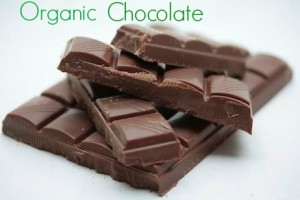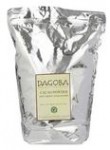This post may contain affiliate links. Read our disclosure here.
 The following is part of an Organic Living Journey Guest Post Series now written by Mariana who has a mother’s heart and scientist’s brain.
The following is part of an Organic Living Journey Guest Post Series now written by Mariana who has a mother’s heart and scientist’s brain.
CHOCOLATE!
Chocolate has been around for at least 2000 years. Early records show that the Aztecs brewed a bitter drink (xocoatl) from cacao seeds, and this is one of the first forms of our modern chocolate. Through the years, we’ve learned to sweeten our chocolate, balancing the rich, bitter taste. Now it feels like we’ve lost our way and are using more sugar than chocolate. Do you prefer your chocolate dark and rich or light and sweet?
I love chocolate. (What’s not to like?) I like it dark, creamy, crunchy…any way it comes. Despite my appreciation for chocolate, I really don’t know too much about this food. Today, we’re going to clarify all the chocolate terminology, learn about how it’s processed, talk about its health benefits, and enjoy a cup of organic hot cocoa.
The Basics
Chocolate begins with the cacao bean. These tough little pods grow on trees and are harvested and fermented with fruit. The beans are then peeled and the seeds processed.
You say cocoa, I say cacao…
Cacao – the name “cacao” can be used when talking about the actual cacao plant or any unprocessed form of the cacao plant.
Raw Cacao – when the cacao bean is not roasted before being processed. All processing occurs at low temperatures. Seed retains all enzymes, vitamins, minerals, and antioxidants.
Cacao Nib (shown above) – The cacao seed is broken into small pieces, resulting nibs. They are unprocessed and raw.
Raw Cacao Powder – The cacao seed (or nibs) is cold-pressed to remove the fat (cocoa butter) and then ground into powder. Processed but still raw.
Cocoa powder- same as raw cacao powder except the cacao seed is roasted before being processed.
Cocoa butter – the naturally-occurring fat in the cacao seed. It is extracted and then remixed with cocoa powder at varying concentrations. It is also sold to other industries for use in cosmetics, etc.
Chocolate liquor – the cacao seed gets roasted and ground into a paste, not pressed. Then it’s melted. When cooled, this is considered unsweetened baking chocolate. No cocoa butter is extracted. This is not the same thing as chocolate liqueur.
How is conventional chocolate produced?
Let’s rip off the band-aid: conventionally farmed cacao is awful for the environment. Second only to cotton, cacao farming uses the highest volume of synthetic and toxic pesticides. Synthetic pesticides, herbicides, and fertilizers affect the environment, the crop, and workers. As of today, there has been research into creating genetically-modified cacao, but there has not been any produced.
How is organic chocolate produced?

For a chocolate (or any food product) to be considered “organic” it must contain at least 95% organic ingredients. To make organic cacao, the farm replaces conventional fertilizers and soil conditioners with crop rotation practices and all-natural fertilizers (manure). Synthetic and toxic pesticides are never used, replaced with all-natural alternatives. These organic practices create a more sustainable crop, have a lower environmental impact, and are better for the workers who will not be exposed to the synthetic chemicals. On the manufacturing end, USDA Certified Organic chocolate also guarantees that no artificial flavors, dyes, or GMOs (genetically modified organisms) find their way into your chocolate.
Health Benefits?
We’ve all heard of the supposed health benefits chocolate provides. Are they true? Yes and no. It depends on the chocolate. We’re going to discuss the health benefits from one of the purest forms of chocolate, the raw cacao nib.
-high in iron
-one of the highest sources of magnesium available – helps balance brain chemistry
-high in manganese (helps oxygenate your blood)
-rich in sulfur – which helps grow healthy hair, nails, and skin
-good source of other minerals such as zinc, potassium, and calcium
-rich in antioxidant flavonoids – great for heart health, circulation, blood pressure regulation, and protection against toxins!
-increases release of serotonin which acts as a natural antidepressant and reduces PMS mood changes
-increases release of endorphins (and endorphins make you happy!)
-increases release of phenylethylamine – a mood enhancer
-raw cacao is also a good source of healthy enzymes and dietary fiber
Health Concerns
On its own, pure chocolate has no health concerns. So, if you enjoy eating 100% pure cacao, go for it. I’m not that hardcore, and that’s where sugar comes into the equation. Since chocolate is more palatable when it’s sweetened, this raises concerns over high calories, glycemic index (GI), etc. The good news? If you’re buying an organic chocolate, then it’s likely sweetened with organic sugar (or a similar organic sweetener). Organic sugar has a significantly lower GI than refined white sugar.
Shopping Around
“Organic” chocolate and “expensive” chocolate usually go hand in hand. Why? We’ll get into the details next week, but to sum up: organic chocolates can’t use the cheap emulsifiers and fillers that conventional chocolates use. Fortunately, I’ve found that the price difference in organic vs. conventional cocoa powder isn’t significant! For example, a 9 oz. container of Hershey’s Cocoa Powder costs about $4 ($0.44/ounce). The organic equivalent will be about $0.58 per ounce when bought in a bulk, 5-lb bag. (Get it for $0.46/ounce with Amazon’s subscribe and save option!)
Perspective
Chocolate has been shown to have some great health benefits. However, the toxins and pesticides in conventional chocolate are worrisome. Cocoa is one of the most heavily-treated crops, giving you a pretty hefty dose of pesticides and toxins. If you’re making an effort to reduce toxins, consider adding chocolate to you “buy organic” list. Not convinced that organic chocolate makes a difference? That’s ok. Start by comparing prices. Sometimes organic brands are on sale, marked down to great prices. Sometimes the price difference between organic and conventional is minimal. Organic may be more affordable than you would expect.
Next week….
we will take another look at chocolate, this time the final consumer product. What else is added into conventional chocolate candy? What are some of those chemical additives, anyways? Can you make your own at home?




